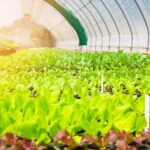Are you interested in starting your own vegetable garden but have no idea where to begin? If so, this article is perfect for you. In this beginner’s guide to vegetable gardening, we will cover all the essentials you need to know to get started on your very own garden.
From selecting the right location and essential tools, to choosing the perfect vegetables and dealing with common pests, we’ve got you covered. So, let’s dive into the basics of vegetable gardening and get you on your way to a successful harvest.
Starting a vegetable garden can be a rewarding and fulfilling experience, but it can also be overwhelming for beginners. That’s why it’s important to start with a good understanding of the basics before diving in. This introduction section will provide an overview of what you need to know as a beginner vegetable gardener, including tips and advice that will set you up for success.
Whether you have a green thumb or are completely new to gardening, this article will give you the knowledge and confidence to start your very own vegetable garden. With the right information at your fingertips, along with some passion and dedication, you’ll soon be enjoying the fruits (and vegetables) of your labor. Ready to get your hands dirty and grow your own delicious produce? Let’s get started.
Selecting the Perfect Location for Your Vegetable Garden
When it comes to starting a vegetable garden, one of the most important decisions you’ll make is where to place it. The perfect location for your vegetable garden can greatly impact the success of your plants and the overall productivity of your garden. Here are some key factors to consider when selecting the perfect location for your beginner vegetable gardeners essentials:
Sunlight and Shade
One of the most critical factors in choosing a location for your vegetable garden is access to sunlight. Most vegetables require at least 6-8 hours of direct sunlight each day. Look for an area in your yard that receives ample sunlight and minimal shade from trees or structures. If you have limited space with high levels of shade, consider planting shade-tolerant vegetables such as lettuce, spinach, or kale.
Accessibility to Water
Another important consideration is the proximity to a water source. Your vegetable garden should be located close enough to a water spigot or hose for convenient watering. It’s also essential to ensure proper drainage, as standing water can lead to root rot and other issues.
Protection From Wind and Pests
Consider the potential impact of strong winds on your vegetable garden. If possible, choose a location that is sheltered from strong winds, as they can damage young plants and inhibit growth. Additionally, consider any potential pest issues in your chosen location and take steps to protect your plants accordingly.
By carefully considering these factors and selecting the perfect location for your vegetable garden, you will set yourself up for a successful growing season and an abundant harvest of fresh, delicious produce.
Essential Tools and Equipment for Beginner Vegetable Gardeners
When starting a vegetable garden, having the right tools and equipment is essential for success. As beginner vegetable gardeners, it’s important to invest in quality items that will make your gardening experience more efficient and enjoyable.
Some essential tools to have on hand include a sturdy trowel for planting and transplanting, a garden fork for turning and aerating the soil, a hose or watering can for irrigation, and a pair of gardening gloves to protect your hands while working in the garden.
In addition to basic hand tools, beginner vegetable gardeners may also want to consider investing in some additional equipment to make their gardening experience easier. A durable wheelbarrow can be incredibly useful for transporting soil, compost, and plants around the garden.
A sharp pair of pruners is also essential for trimming and harvesting vegetables as they ripen. Additionally, beginner vegetable gardeners may find it helpful to have a garden hoe for weeding and a sturdy rake for leveling the soil and clearing debris.
For those who are looking to start their first vegetable garden, having the right tools and equipment can make all the difference. Investing in these essentials will not only make gardening more efficient but can also contribute to a more successful harvest. By acquiring these tools early on, beginner vegetable gardeners can set themselves up for a rewarding and enjoyable gardening experience.
Choosing the Right Vegetables for Your Garden
When it comes to choosing the right vegetables for your garden, there are a few important factors to consider. As a beginner vegetable gardener, it’s essential to start with vegetables that are relatively easy to grow and maintain. Here are some popular choices for beginner vegetable gardeners:
- Tomatoes
- Peppers
- Zucchini
- Green beans
- Lettuce
These vegetables are known for being relatively low-maintenance and can thrive in a variety of climates. Additionally, they are versatile and can be used in a wide range of recipes, making them a great option for beginners.
It’s also important to consider the available space in your garden when choosing vegetables to plant. If you have limited space, you may want to focus on compact plants or those that can be grown vertically, such as cucumbers or pole beans. On the other hand, if you have plenty of space, you can consider planting larger crops like pumpkins or watermelons.
Lastly, consider your own personal preferences and what kinds of vegetables you and your family enjoy eating. There’s nothing more rewarding than growing and harvesting vegetables that you love to eat. By choosing vegetables that appeal to your tastes, you’ll be more motivated to put in the effort required for a successful harvest.
Overall, selecting the right vegetables for your garden is an exciting part of the gardening process. By considering factors such as ease of maintenance, available space, and personal preferences, beginner vegetable gardeners can set themselves up for a successful and enjoyable growing experience.
Preparing the Soil for a Successful Harvest
Once you have chosen the perfect location for your vegetable garden, the next crucial step in ensuring a successful harvest is preparing the soil. Proper soil preparation is essential for providing the nutrients and environment necessary for healthy plant growth. Here are some tips and guidelines for beginner vegetable gardeners to prepare their soil effectively:
- Test your soil: Before planting, it’s important to test your soil to determine its pH level and nutrient content. This will help you identify any deficiencies and allow you to make necessary amendments.
- Amend the soil: Based on the results of your soil test, add organic matter such as compost, well-rotted manure, or peat moss to improve the soil structure and fertility. This will provide essential nutrients to support plant growth.
- Remove weeds and debris: Clear the area of any weeds, rocks, or debris that may hinder plant growth or interfere with root development. This will create a clean and optimal environment for your vegetables to thrive.
In addition to these steps, it’s important to consider the specific needs of the vegetables you plan to grow. Some plants may require more acidic soil, while others thrive in alkaline conditions. By understanding the individual requirements of your chosen vegetables, you can tailor your soil preparation to meet their needs and set them up for success.
Ultimately, investing time and effort into preparing your soil will pay off with a bountiful harvest of healthy and vibrant vegetables. Remember that good soil is the foundation of a productive garden, so don’t overlook this crucial step in your gardening journey as a beginner vegetable gardener’s essentials.
Planting and Caring for Your Vegetable Garden
Planting and caring for a vegetable garden can be a rewarding experience, especially for beginner vegetable gardeners. With the right knowledge and tools, you can ensure a successful and bountiful harvest. In this section, we will discuss the essential steps and tips for planting and caring for your vegetable garden.
Planning Your Garden Layout
Before planting your vegetables, it’s important to plan the layout of your garden. Consider factors such as sunlight exposure, spacing between plants, and potential height of the mature plants. Some vegetables may require more space or shade than others, so make sure to research the specific requirements for each type of vegetable you plan to grow.
Proper Planting Techniques
When it comes to planting your vegetables, it’s crucial to follow proper techniques to ensure healthy growth. Make sure to dig holes at the appropriate depth for each plant, loosen the soil to allow for good root development, and water the plants immediately after planting. Additionally, consider using mulch around your plants to retain moisture in the soil and prevent weed growth.
Caring for Your Garden
Caring for your vegetable garden involves regular maintenance such as watering, fertilizing, and monitoring for pests or diseases. It’s important to water your plants consistently, especially during hot and dry periods. Additionally, consider using organic fertilizers to provide essential nutrients for healthy plant growth. Keep a close eye on your plants for any signs of pests or diseases, and take proactive measures to address these issues before they escalate.
By following these essential tips for planting and caring for your vegetable garden, beginner gardeners can set themselves up for a successful growing season. With patience and dedication, you’ll soon be able to enjoy a plentiful harvest of fresh vegetables from your own backyard.
Dealing With Common Pests and Problems in Vegetable Gardening
Every beginner vegetable gardener knows that dealing with common pests and problems is an inevitable part of the gardening process. From bugs to diseases, there are a variety of issues that can arise in your garden. However, with the right knowledge and strategies, you can effectively manage these challenges and ensure a successful harvest.
One essential for tackling pests and problems is to regularly inspect your plants. Keep an eye out for any signs of damage, discoloration, or unusual growth. Identifying issues early on can help prevent them from spreading and becoming more difficult to manage. Additionally, familiarize yourself with the common pests and diseases that affect the specific vegetables you are growing. This will enable you to take proactive measures to prevent infestations and infections.
Another important aspect of dealing with pests and problems is practicing good garden maintenance. This includes proper watering, weeding, and maintaining healthy soil. Healthy plants are more resilient to pests and diseases, so providing optimal growing conditions can go a long way in preventing potential issues.
Consider implementing natural pest control methods such as companion planting, using beneficial insects, or making homemade organic sprays. These environmentally friendly approaches can help manage pests without harmful chemicals that could affect your health or the ecosystem of your garden.
By being proactive and implementing these strategies, beginner vegetable gardeners can effectively handle common pests and problems while promoting a healthy and thriving garden.
Overall, understanding the importance of pest management strategies is crucial for every beginner vegetable gardener’s success. With the right knowledge and approach, you can minimize potential issues and create a flourishing garden full of bountiful produce.
Harvesting and Enjoying the Fruits (And Vegetables) of Your Labor
Once you have diligently cared for your vegetable garden, the time will eventually come when you can enjoy the fruits of your labor. Harvesting your vegetables at the right time is crucial to enjoying them at their peak flavor and nutrition. Most vegetables are best harvested in the morning, as this is when they are the freshest and most hydrated.
It’s important not to rush the harvesting process, as picking vegetables before they are fully ripe can lead to a loss of flavor and nutrients. For example, tomatoes should be firm and fully colored before picking, while lettuce should be harvested when it reaches full size but before it bolts. Using a sharp pair of gardening shears or a knife will help prevent damage to both the plants and produce.
After harvesting, it’s time to savor and enjoy your homegrown vegetables. Whether you choose to eat them raw or incorporate them into delicious meals, there is something incredibly rewarding about eating produce that you have grown yourself. Taking the time to savor the flavors of your harvest can also provide inspiration for future planting decisions. As a beginner vegetable gardener, experiencing this process firsthand can be incredibly gratifying.
| Vegetable | Harvesting Tips |
|---|---|
| Tomatoes | Pick when fully colored and firm |
| Lettuce | Harvest when it reaches full size but before bolting |
| Zucchini | Pick when young and tender, about 6-8 inches long |
Conclusion
In conclusion, starting and maintaining a successful vegetable garden can be a rewarding and fulfilling experience for beginner vegetable gardeners. With the right knowledge, tools, and determination, anyone can enjoy the benefits of growing their own fresh produce. By following the tips and guidelines provided in this article, you can create a thriving garden that provides delicious, homegrown vegetables for you and your family to enjoy.
It’s important for beginner vegetable gardeners to remember that gardening is a learning process. Don’t be discouraged by setbacks or challenges along the way. Every mistake is an opportunity to gain valuable experience and improve your gardening skills. With time and patience, you will become more proficient at caring for your garden and reaping the rewards of your hard work.
As you embark on your journey as a beginner vegetable gardener, remember that there is a supportive community of experienced gardeners who are willing to offer advice and guidance. Don’t hesitate to seek out local gardening groups or online forums where you can connect with fellow enthusiasts.
By sharing knowledge and experiences, you can continue to learn and grow as a gardener. With dedication, passion, and the essentials outlined in this article, you can cultivate a beautiful and bountiful vegetable garden.

If you’re looking to get into vegetable gardening, or are just looking for some tips on how to make your current garden better, then you’ve come to the right place! My name is Ethel and I have been gardening for years. In this blog, I’m going to share with you some of my best tips on how to create a successful vegetable garden.





